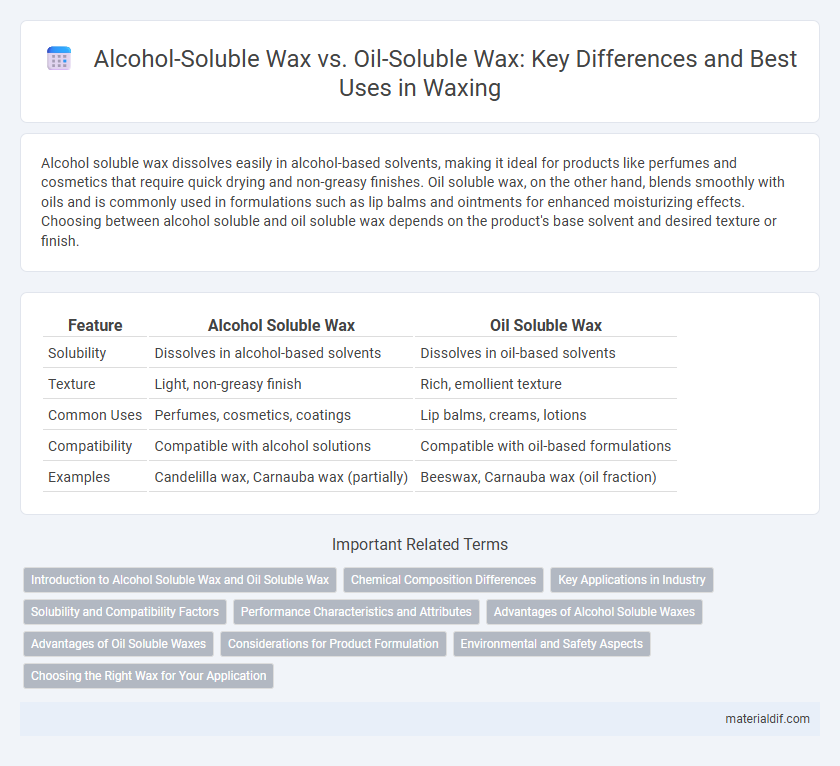Alcohol soluble wax dissolves easily in alcohol-based solvents, making it ideal for products like perfumes and cosmetics that require quick drying and non-greasy finishes. Oil soluble wax, on the other hand, blends smoothly with oils and is commonly used in formulations such as lip balms and ointments for enhanced moisturizing effects. Choosing between alcohol soluble and oil soluble wax depends on the product's base solvent and desired texture or finish.
Table of Comparison
| Feature | Alcohol Soluble Wax | Oil Soluble Wax |
|---|---|---|
| Solubility | Dissolves in alcohol-based solvents | Dissolves in oil-based solvents |
| Texture | Light, non-greasy finish | Rich, emollient texture |
| Common Uses | Perfumes, cosmetics, coatings | Lip balms, creams, lotions |
| Compatibility | Compatible with alcohol solutions | Compatible with oil-based formulations |
| Examples | Candelilla wax, Carnauba wax (partially) | Beeswax, Carnauba wax (oil fraction) |
Introduction to Alcohol Soluble Wax and Oil Soluble Wax
Alcohol soluble wax dissolves in alcohol-based solvents, making it ideal for formulations requiring quick drying and easy removal, commonly used in cosmetics and personal care products. Oil soluble wax, on the other hand, dissolves in oil-based solvents and excels in providing water resistance, texture, and durability in products like lip balms and ointments. Understanding the solubility properties of these waxes is crucial for selecting the right ingredient to achieve desired texture, stability, and performance in various formulations.
Chemical Composition Differences
Alcohol soluble waxes are primarily composed of long-chain fatty alcohols and fatty acids that dissolve in alcohol-based solvents, exhibiting polar functional groups. Oil soluble waxes contain hydrocarbons, esters, and fatty acids with non-polar chains that readily dissolve in oil-based mediums. This fundamental chemical composition difference affects their solubility profiles and functional applications in cosmetic and industrial formulations.
Key Applications in Industry
Alcohol soluble waxes are predominantly used in cosmetics and personal care products for their smooth texture and quick-drying properties, enhancing formulations like lipsticks and mascaras. Oil soluble waxes are favored in industrial applications such as rubber processing, inks, and coatings due to their excellent compatibility with oil-based systems and superior water resistance. Both types of waxes play critical roles in manufacturing, with alcohol soluble waxes improving product aesthetics and oil soluble waxes enhancing durability and performance.
Solubility and Compatibility Factors
Alcohol soluble wax dissolves effectively in alcohol-based solvents, exhibiting high compatibility with formulations containing ethanol or isopropanol, making it ideal for cosmetics like lipsticks and mascaras. Oil soluble wax, on the other hand, dissolves in hydrocarbon or oil-based solvents and blends seamlessly with petroleum jelly, mineral oil, or vegetable oils, enhancing texture and stability in products such as lip balms and ointments. Understanding the solubility parameters and solvent polarity is essential for selecting the appropriate wax type to ensure optimal dispersion, consistency, and performance in targeted applications.
Performance Characteristics and Attributes
Alcohol soluble wax exhibits excellent compatibility with polar solvents and provides a smooth, non-greasy finish, making it ideal for cosmetics and coatings requiring quick drying and enhanced film formation. Oil soluble wax offers superior dispersion in non-polar oils, delivering enhanced gloss, emollience, and long-lasting texture stability in formulations like lipsticks and creams. The choice between alcohol soluble and oil soluble waxes predominantly hinges on solvent system compatibility and desired sensory attributes.
Advantages of Alcohol Soluble Waxes
Alcohol soluble waxes offer superior compatibility with alcohol-based formulations, enhancing product uniformity and stability. Their rapid dissolution in alcohol enables efficient processing and improved texture in cosmetic and pharmaceutical applications. These waxes also provide excellent film-forming properties, resulting in long-lasting wear and water resistance in finished products.
Advantages of Oil Soluble Waxes
Oil soluble waxes offer superior compatibility with oil-based formulations, enhancing the texture and stability of cosmetic and pharmaceutical products. Their hydrophobic nature improves spreadability and imparts a long-lasting, non-greasy finish in lipsticks, creams, and lotions. These waxes also provide better moisturization and a smoother feel compared to alcohol soluble waxes, making them ideal for high-performance skincare applications.
Considerations for Product Formulation
Alcohol soluble waxes dissolve readily in alcohol-based solvents, making them ideal for clear, fast-drying formulations like sprays and deodorants. Oil soluble waxes blend effectively with oils and fats, providing enhanced texture, stability, and moisture retention in creams and balms. Product formulators must consider solvent compatibility, desired texture, and end-use performance when choosing between alcohol soluble and oil soluble waxes.
Environmental and Safety Aspects
Alcohol soluble wax dissolves in alcohol-based solvents, offering lower volatility and reduced flammability compared to oil soluble wax, which dissolves in hydrocarbons and poses higher risks of environmental pollution due to VOC emissions. Oil soluble wax often contains petroleum-derived components that contribute to longer biodegradation times and potential soil and water contamination. Selecting alcohol soluble wax enhances safety by minimizing flammable hazards during manufacturing and reduces ecological impact through better biodegradability and lower toxic residuals.
Choosing the Right Wax for Your Application
Alcohol soluble wax dissolves in alcohol-based solvents, making it ideal for cosmetic formulations like mascaras and lipsticks that require quick drying and a non-greasy finish. Oil soluble wax, on the other hand, blends seamlessly with oil-based products such as creams, balms, and ointments, providing better texture and stability in hydrophobic environments. Selecting the right wax depends on the solvent system of your formulation to ensure optimal solubility, texture, and performance in the final product.
Alcohol Soluble Wax vs Oil Soluble Wax Infographic

 materialdif.com
materialdif.com